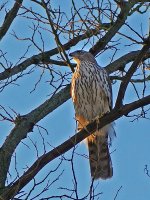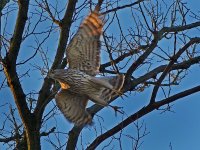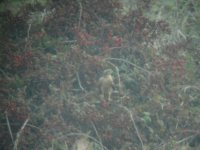-
Welcome to BirdForum, the internet's largest birding community with thousands of members from all over the world. The forums are dedicated to wild birds, birding, binoculars and equipment and all that goes with it.
Please register for an account to take part in the discussions in the forum, post your pictures in the gallery and more.
You are using an out of date browser. It may not display this or other websites correctly.
You should upgrade or use an alternative browser.
You should upgrade or use an alternative browser.
ID bird of prey/Berlin Germany (1 Viewer)
- Thread starter darwin1601
- Start date
More options
Who Replied?BobbitWorm45
Well-known member
That's an immature Goshawk
That's right, a juvenile Goshawk, now 2cy, but strictly speaking sexually mature - particularly if it's a female, cause that sex may proceed with the first breeding season now, laying fertile eggs and all - albeit not anywhere near having acquired even the first adult plumage.
That will not be complete until well into the autumn, when the bird then is about 18 months old.
Peter
That will not be complete until well into the autumn, when the bird then is about 18 months old.
Peter
Valéry Schollaert
Respect animals, don't eat or wear their body or s
The (vertical) stripes on the breast are typical of young Goshawks in Europe. European Sparrowhawk is always barred (horizontal lines) even in juveniles.
Valéry Schollaert
Respect animals, don't eat or wear their body or s
That's right, a juvenile Goshawk, now 2cy, but strictly speaking sexually mature - particularly if it's a female, cause that sex may proceed with the first breeding season now, laying fertile eggs and all - albeit not anywhere near having acquired even the first adult plumage.
That will not be complete until well into the autumn, when the bird then is about 18 months old.
Peter
Interesting indeed, in North America I heard about 2 "immatures" (in plumage) Cooper's Sparrowhawk breeding and producing youngsters... strange enough, isn't it?
darwin1601
Well-known member
Thank you for all of the replies and help!
BobbitWorm45
Well-known member
That's right, a juvenile Goshawk, now 2cy, but strictly speaking sexually mature - particularly if it's a female, cause that sex may proceed with the first breeding season now, laying fertile eggs and all - albeit not anywhere near having acquired even the first adult plumage.
That will not be complete until well into the autumn, when the bird then is about 18 months old.
Peter
Yes, I should have chosen my description 'immature' more carefully and used 'immature plumage' or 'sub-adult plumage'.
Simon Wates
Well-known member
That's right, a juvenile Goshawk, now 2cy, but strictly speaking sexually mature - particularly if it's a female, cause that sex may proceed with the first breeding season now, laying fertile eggs and all - albeit not anywhere near having acquired even the first adult plumage.
That will not be complete until well into the autumn, when the bird then is about 18 months old.
Peter
Thanks Peter - another nugget of info from you, I'd imagined that the males would be sexually mature well before the females - as I understand, our (Iberian) larger eagles are. Some pairs of Spanish Imperial Eagle here have very young males that are sometimes referred to as "toyboys" by their monitors.
birdmeister
Well-known member

That's right, a juvenile Goshawk, now 2cy, but strictly speaking sexually mature - particularly if it's a female, cause that sex may proceed with the first breeding season now, laying fertile eggs and all - albeit not anywhere near having acquired even the first adult plumage.
That will not be complete until well into the autumn, when the bird then is about 18 months old.
Peter
Peter, I must be missing something, but I always thought "juvenile" referred to birds before their first winter, and "immature" was a broad term denoting any non-adult bird.
Hope I'm not hijacking this thread too much.
Valéry Schollaert
Respect animals, don't eat or wear their body or s
Peter, I must be missing something, but I always thought "juvenile" referred to birds before their first winter, and "immature" was a broad term denoting any non-adult bird.
Hope I'm not hijacking this thread too much.
Juvenile means a bird having its first plumage (before first moult), immature is a bird that is not mature. Juveniles are usually immatures but there are plenty of non-juvenile immatures!
Interesting indeed, in North America I heard about 2 "immatures" (in plumage) Cooper's Sparrowhawk breeding and producing youngsters... strange enough, isn't it?
FYI that is noted under the paragraph about NESTING at page 183 in Wheeler's RAPTORS of Western North America. "One-year-old females in juvenile plumage often nest with adult males. Rarely, two juvenile-aged birds pair and nest." An identical statement is found at page 175 of his Eastern Edition.
birdmeister
Well-known member

Juvenile means a bird having its first plumage (before first moult), immature is a bird that is not mature. Juveniles are usually immatures but there are plenty of non-juvenile immatures!
Thanks very much for that.
Valéry Schollaert
Respect animals, don't eat or wear their body or s
FYI that is noted under the paragraph about NESTING at page 183 in Wheeler's RAPTORS of Western North America. "One-year-old females in juvenile plumage often nest with adult males. Rarely, two juvenile-aged birds pair and nest." An identical statement is found at page 175 of his Eastern Edition.
Thanks :t:
Brett Richards
Well-known member

The (vertical) stripes on the breast are typical of young Goshawks in Europe. European Sparrowhawk is always barred (horizontal lines) even in juveniles.
Not always. I recall a small hawk on Scilly in autumn 2010 which had a streaky breast, giving rise to thoughts of Sharp-shinned Hawk from across the Atlantic. Promising enough for me to twitch it (unsuccessfully), but it was eventually trapped and proved to be a rather small Sparrowhawk. I also saw the bird in the (terrible) attached photo at Flamborough, England, on 8 September 2010. The breast is thinly streaked as can be seen. The legs perhaps look thick in this photo, but it wasn't a large bird and never really a candidate for Goshawk.
Brett
Attachments
Valéry Schollaert
Respect animals, don't eat or wear their body or s
Not always. I recall a small hawk on Scilly in autumn 2010 which had a streaky breast, giving rise to thoughts of Sharp-shinned Hawk from across the Atlantic. Promising enough for me to twitch it (unsuccessfully), but it was eventually trapped and proved to be a rather small Sparrowhawk. I also saw the bird in the (terrible) attached photo at Flamborough, England, on 8 September 2010. The breast is thinly streaked as can be seen. The legs perhaps look thick in this photo, but it wasn't a large bird and never really a candidate for Goshawk.
Brett
Well, the photo is not enough to judge, the throat is partially streaked in juvenile sparrowhawk then breast and belly barred. On you photo, we don't see lower breast and belly properly.
Now, whatever is the feature you give to ID, there are always possible exceptions with albino, leucistic, melanistic or other non typical plumages. When you teach about Great Egret in UK, you can say a bird of the size of Grey Heron is a Great Egret... you would probably not add "or a albino Grey Heron, or an extreme vagrant white form of Great Blue Heron"... would you?
Brett Richards
Well-known member

Well, the photo is not enough to judge, the throat is partially streaked in juvenile sparrowhawk then breast and belly barred. On you photo, we don't see lower breast and belly properly.
Now, whatever is the feature you give to ID, there are always possible exceptions with albino, leucistic, melanistic or other non typical plumages. When you teach about Great Egret in UK, you can say a bird of the size of Grey Heron is a Great Egret... you would probably not add "or a albino Grey Heron, or an extreme vagrant white form of Great Blue Heron"... would you?
It is a poor photo, but you can see the breast is streaked, which was my point.
Brett
Valéry Schollaert
Respect animals, don't eat or wear their body or s
It is a poor photo, but you can see the breast is streaked, which was my point.
Brett
We see the breast is streaked, but the photo is so bad that we don't see it is a Eurasian Sparrowhawk... so this is not proving your point. In case you prove it, means there is an exception on Earth, it doesn't change the fact than we separate young Goshawk from Sparrowhawk, in Europe, by streaked breast.
Brett Richards
Well-known member

We see the breast is streaked, but the photo is so bad that we don't see it is a Eurasian Sparrowhawk... so this is not proving your point. In case you prove it, means there is an exception on Earth, it doesn't change the fact than we separate young Goshawk from Sparrowhawk, in Europe, by streaked breast.
The Scilly bird referred to in my first post can be seen here http://birdingfrontiers.com/2010/11/03/scilly-hawk . While not confusable with Goshawk, it does prove my point that Sparrowhawks don't always have barred breasts.
Brett
Valéry Schollaert
Respect animals, don't eat or wear their body or s
The Scilly bird referred to in my first post can be seen here http://birdingfrontiers.com/2010/11/03/scilly-hawk . While not confusable with Goshawk, it does prove my point that Sparrowhawks don't always have barred breasts.
Brett
And I repeat, even if this is proven that the bird you refer is an Eurasian Sparrowhawk, it is not a reason to confuse someone who might want to learn and destroy the basic identification feature, such Accipiter in Europe with stripes is a young goshawk.
If you disagree, you have to make a comment to all posts sharing identification and say "except in albino", "except in melanistic", "except in an atypical individual seen once 68 years ago", etc. Good luck.

The Scilly bird referred to in my first post can be seen here http://birdingfrontiers.com/2010/11/03/scilly-hawk . While not confusable with Goshawk, it does prove my point that Sparrowhawks don't always have barred breasts.
Brett
Interesting Sprawk, thanks for sharing
Users who are viewing this thread
Total: 2 (members: 0, guests: 2)






